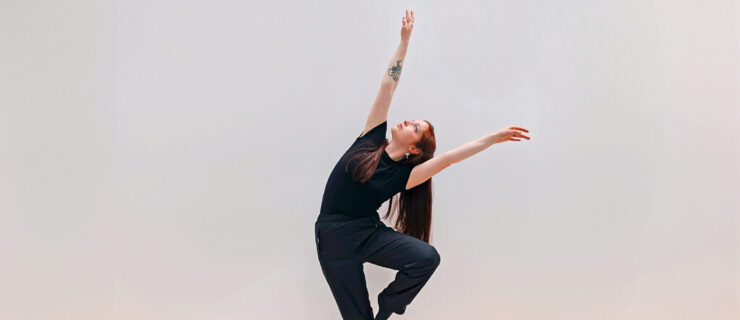A Dancer’s Guide to Managing Panic Attacks
Alex Patrick, a Dallas-based dance instructor and the founder of SHAPPE Dance Company, has experienced intense self-doubt as well as an immense amount of pressure over the course of her career. After landing a big role, she often felt undeserving and inadequate. Sometimes, the compounding stress and difficult emotions she felt about dance would lead Patrick to have panic attacks. “Most of my panic attack moments were related to big-scale thoughts, like ‘There’s not a place for me in the dance world. Why, in this thing that I love so much, is there nowhere for me to go? Why is there nowhere I feel like I have a voice, or like I can be myself?’ ” Patrick explains.
Now, Patrick strives to bring her firsthand knowledge of mental health into the classroom—to support her students not only in their dance technique and performance, but also as they cope with the challenging emotions that can arise in the studio and onstage.
What Is a Panic Attack?
Josh Spell, MSW, LICSW, consulting therapist for Pacific Northwest Ballet and owner of Flexible Mind Counseling, describes a panic attack as a state of “overwhelm, in terms of your nervous system,” adding that panic attacks are tied to the body’s fight-or-flight response, an evolutionary reaction designed to keep us safe from danger.
Individuals having a panic attack might experience heart palpitations, sweating, trembling, shortness of breath, feelings of choking, chest pain, nausea, dizziness, lightheadedness, chills or sensations of heat, and/or numbness and tightness. Spell also says panic attacks can cause depersonalization or derealization, which means a person feels out of touch with their body and/or the current moment. “Dancers and clients that I have worked with have said, ‘I feel like I’m having a heart attack, I feel this immense pressure and weight,’ ” Spell says. “It is very destabilizing and individuals often freeze.”
Although sometimes panic attacks can have seemingly no cause, a stressful environment or a fear of losing control can be potential triggers. People can be triggered by situations ranging from an upcoming performance to a concern about their health.
How Do Panic Attacks Affect Dancers?
Although panic attacks can be incredibly scary and debilitating for anyone, the performance-based nature of dance introduces additional challenges. For Patrick, the intense anxiety that sometimes resulted in panic attacks inhibited her from attending auditions. “I felt, because of my anxiety, I wouldn’t be able to make it through auditions,” she remembers.
Spell adds that panic attacks can also lead to avoidance or an increase of anxiety in situations that precipitated an episode in the past. For example, if a dancer experienced a panic attack prior to a performance, they might develop increased performance anxiety, or they might even avoid a certain step due to fear.
“Overall, this can affect a dancer’s sense of self, and it can definitely affect their confidence,” Spell says. “It shows up as a barrier to being able to put yourself fully in and take those risks that it takes to be a dancer. It’s sort of this conditioning that starts to evolve into a more paralyzing state.”
Tools for Treatment and Coping
For dancers experiencing panic attacks, Spell recommends seeking professional assistance. Mental health professionals can provide tailored guidance to help navigate the best treatment options. Spell says that providers will usually start by explaining the biology of a panic attack. Then an exposure-based treatment, which helps decrease the body’s fear response when approaching a trigger, might be used. Distress-tolerance skills, like mindfulness and grounding techniques, are often taught along with treatment.
The lessons learned in therapy can be implemented whenever panic and anxiety begin to take over. For example, exercises that divert attention toward noticing the five senses can be helpful in times of distress. Spell recommends sensory items, like fidget spinners or squishy balls, and Patrick suggests aromatherapy, as well as a visual exercise called “find your rainbow,” which involves identifying one item in your surrounding environment that corresponds to each color of the rainbow. She also highlights the importance of taking breaks during class or rehearsal for dancers who need time to use these skills to address challenging emotions.
Understanding what’s happening in the body can be important as well. “Sometimes that fight-or-flight response gets taken out of context,” says Spell. “There’s not a saber-toothed tiger chasing after an individual anymore, but maybe stepping into an audition or getting ready to go onstage feels like you’re being chased. You can remind yourself, ‘Okay, this is my body’s way of protecting me, but I don’t need it to protect me right now. There are other ways that I can experience and cope with my anxiety.’ ”
Panic Attack vs. Panic Disorder
According to therapist Josh Spell, MSW, LICSW, about 20 percent of the population will experience a panic attack in their lives. A smaller subset, however, will experience panic disorder, which is characterized by recurring panic attacks, for one month or more, and an accompanying fear of having another panic attack in the future. Panic disorder can also cause individuals to avoid certain stimuli or situations that they think might trigger an episode.





